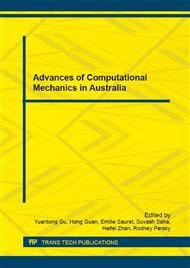[1]
C. Yang, B.N.J. Persson, Molecular Dynamics Study of Contact Mechanics: Contact Area and Interfacial Separation from Small to Full Contact, Phys. Rev. Lett. 100 (2008) 024303.
DOI: 10.1103/physrevlett.100.024303
Google Scholar
[2]
B. Luan, M.O. Robbins, The Breakdown of Continuum Models for Mechanical Contacts, Nature. 435 (2005) 929-932.
DOI: 10.1038/nature03700
Google Scholar
[3]
Y. Mo, K.T. Turner, I. Szlufarska, Friction Laws at the Nanoscale, Nature. 457 (2009) 1116-1119.
DOI: 10.1038/nature07748
Google Scholar
[4]
G.J. Wagner, W.K. Liu, Coupling of Atomistic and Continuum Simulations Using a Bridging Scale Decomposition, J. Comput. Phys. 190 (2003) 249-274.
DOI: 10.1016/s0021-9991(03)00273-0
Google Scholar
[5]
S.P. Xiao, T. Belytschko, A Bridging Domain Method for Coupling Continua with Molecular Dynamics, Comput. Method. Appl. M. 193 (2004) 1645-1669.
DOI: 10.1016/j.cma.2003.12.053
Google Scholar
[6]
B.Q. Luan, S. Hyun, J.F. Molinari, N. Bernstein, and M.O. Robbins, Multiscale Modeling of Two-Dimensional Contacts, Phys. Rev. E. 74 (2006) 046710.
DOI: 10.1103/physreve.74.046710
Google Scholar
[7]
G. Anciaux, J.F. Molinari, Contact Mechanics at the Nanoscale, a 3d Multiscale Approach, Int. J. Numer. Meth. Eng. 79 (2009) 1041-1067.
DOI: 10.1002/nme.2590
Google Scholar
[8]
G. Michal, C. Lu, A. Kiet Tieu, Multiscale Model of Elastic Nanocontacts, Comp. Mater. Sci. 81 (2014) 98-103.
DOI: 10.1016/j.commatsci.2013.06.053
Google Scholar
[9]
S. Tang, T.Y. Hou, W.K. Liu, A Mathematical Framework of the Bridging Scale Method, Int. J. Numer. Meth. Eng. 65 (2006) 1688-1713.
DOI: 10.1002/nme.1514
Google Scholar
[10]
P. Spijker, G. Anciaux, J.F. Molinari, The Effect of Loading on Surface Roughness at the Atomistic Level, Comput. Mech. 50 (2012) 273-283.
DOI: 10.1007/s00466-011-0574-9
Google Scholar
[11]
K.L. Johnson, Contact Mechanics, Cambridge University Press, Cambridge, (1985).
Google Scholar
[12]
B. Luan, M.O. Robbins, Contact of Single Asperities with Varying Adhesion: Comparing Continuum Mechanics to Atomistic Simulations, Phys. Rev. E. 74 (2006) 026111.
DOI: 10.1103/physreve.74.026111
Google Scholar
[13]
S. Cheng, B. Luan, M.O. Robbins, Contact and Friction of Nanoasperities: Effects of Adsorbed Monolayers, Phys. Rev. E. 81 (2010) 016102.
DOI: 10.1103/physreve.81.016102
Google Scholar
[14]
S. Medina, D. Dini, A Numerical Model for the Deterministic Analysis of Adhesive Rough Contacts Down to the Nano-Scale, Int. J. Solids. Struct. 51 (2014) 2620-2632.
DOI: 10.1016/j.ijsolstr.2014.03.033
Google Scholar


